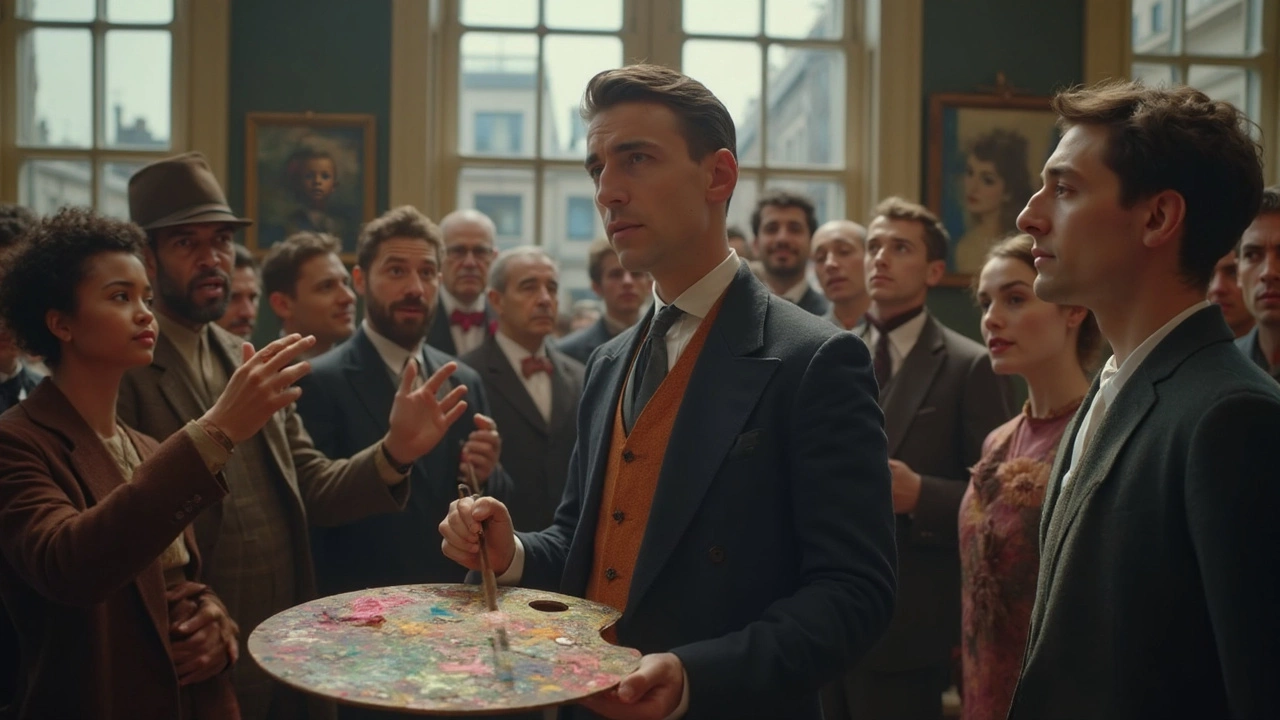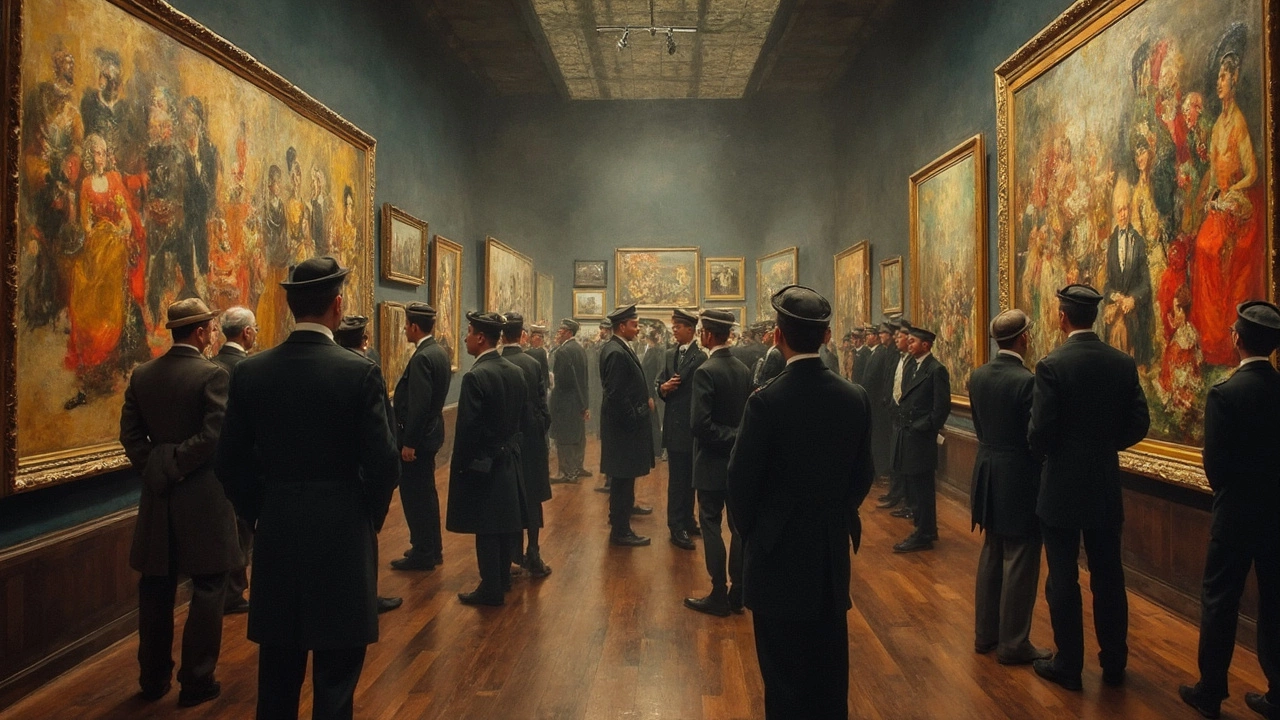Picture this: you walk into an art gallery expecting pretty portraits or landscapes, and instead, you see bold splashes of color and shapes that don’t look like anything real. That’s what happened to people back in the early 1900s when abstract art first hit the scene. It wasn’t just new—it was shocking. Gallery visitors, critics, and even artists themselves demanded, “What does this even mean?”
So, why did abstract art get so much hate? It was a total shake-up. Art had always tried to copy life as closely as possible. Suddenly, artists like Kandinsky and Mondrian decided it was enough with the copying. They wanted to capture moods and ideas, not objects. This felt like chaos to anyone who was used to clear, detailed pictures.
If you’ve ever looked at an abstract painting and felt a little lost, you’re not alone. Many of the world’s top critics at the time called it lazy or even ridiculous. Some people thought anyone could splash paint on a canvas and call it genius. But there’s more going on than meets the eye, and understanding this rough start actually helps you see what’s cool about abstract art now.
- The Birth of Abstract Art and Early Reactions
- Why Abstract Art Faced So Much Pushback
- The Turning Point: How Opinions Started Changing
- Tips for Appreciating Abstract Art Today
The Birth of Abstract Art and Early Reactions
When people talk about abstract art, it usually means paintings or sculptures that don’t try to look like real things—think shapes, lines, and wild colors that you can’t pin down to any object. This new way of making art was pretty much unheard of until the early 1900s. Artists like Wassily Kandinsky and Kazimir Malevich were some of the first to ditch the idea of painting people or landscapes. In 1911, Kandinsky made what many call the first truly abstract painting—no objects, just colors and lines meant to show emotion.
Abstract art didn’t show up out of nowhere. Artists in Europe were already starting to get tired of the old way of painting—making everything look exactly as it does in real life. Photography was becoming more common, so painting a super-realistic portrait felt less impressive. Plus, these artists were soaking up new ideas from music, science, and even psychology.
Most art fans back then weren’t impressed. At the famous Armory Show in New York in 1913, Americans got their first big dose of European modern art. Reactions were intense. Some people laughed, others got mad, and newspapers joked about how anyone could've done it. Here’s what stood out:
- Painters like Kandinsky said their goal wasn’t to show what things looked like, but what they felt like.
- Critics called the early works "scribbles," "childish," or just "shocking."
- Many galleries refused to even hang abstract pieces—calling them meaningless or a "passing craze."
If you ever hear someone ask, “What is that even supposed to be?”, you’re basically hearing a question straight from 1913 all over again. These early reactions show just how much art history was being shaken up at the time.
Today, it’s wild to think that works like Mondrian’s blocky color grids were once joked about. Back then, critics didn’t see skill or meaning behind the odd shapes and colors. Instead, they saw them as a threat to everything they thought modern art should be. The shift to abstract was dramatic because people had to let go of what they always thought art was for.
Why Abstract Art Faced So Much Pushback
The real problem kicked in when abstract art stopped trying to show the world exactly how it looks. For centuries, artists were praised for painting every detail—think about the tiny hairs in a Rembrandt or the serious faces in a da Vinci. Suddenly, abstract painters tossed out tradition and just ran with color, lines, and shapes. People felt like the rules were being thrown out the window.
A lot of the complaints came from the fact that most folks just didn’t “get it.” If a painting didn’t look like anything you could name—no faces, no trees, no nothing—how could you tell if it was good? Critics in the early 1900s even called it “childish scribbles” or “meaningless messes.” Newspapers mocked big shows like the 1913 Armory Show in New York, where Americans saw European modern art up close for the first time. One headline joked, "Is it Art, or is it Madness?"
This clash really wasn’t just about taste. Some experts say the invention of photography played a huge part. When cameras could capture reality perfectly, painters had to find a new job, so to speak. That freaked people out. It made traditional artists worry their work would be seen as old-fashioned, while the public sometimes felt left behind by these sudden, confusing changes.
The art world itself felt divided, too. The salon system, the old boys club that decided what got shown in galleries, kept turning down anything too new. Museums and collectors in places like Paris and London focused on the safe stuff. Money talked—if they didn’t buy it, it didn’t get seen. It took decades for this to shift.
Check out just how different the public’s reaction to traditional art and abstract art looked at the time:
| Type of Art | Common Reaction (1910s-1920s) |
|---|---|
| Realist Paintings | Amazed by the skill, wanted for home display |
| Abstract Art | Confused, sometimes angry, often mocked in the press |
So, it’s not just that folks disliked abstract art—some actually felt threatened by it. They worried it would ruin what art was supposed to be. And honestly? That stubborn resistance shaped art history more than you might think.

The Turning Point: How Opinions Started Changing
Things didn’t stay bad forever for abstract art. Turns out, all it took was a handful of gutsy artists, some curious critics, and a couple of smart collectors to shift the story. In 1913, the Armory Show in New York rattled the art world by showing wild, new works from Europe, including pieces by Kandinsky and Duchamp. Crowds packed in—some laughed, some got mad, but nobody ignored it. That show is often called America’s big wake-up call for modern art.
Collectors like Peggy Guggenheim made a real difference, too. She bought works nobody else wanted, put them in front of the public, and said, “Look closer.” Museums eventually joined in—the Museum of Modern Art (MoMA) in New York started collecting and showing abstract art in the 1930s. Having respected places back this new look helped legitimize it for the rest of society.
The critics switched sides, too. Clement Greenberg, a famous New York art critic, said in 1939,
"The essence of Modernism lies, as I see it, in the use of characteristic methods of a discipline to criticize the discipline itself."
Basically, he believed abstract art was doing what art’s supposed to do—make us see the world differently. This kind of thinking started changing minds.
If you’re into numbers, check out this quick table. It shows how museums’ collections of modern art exploded over the 20th century because of abstract art’s rise:
| Year | MoMA Collection Size |
|---|---|
| 1929 | 8 paintings |
| 1950 | 150+ artworks (lots of abstract) |
| 1970 | Over 1,000 artworks |
Once these new styles got headline spots in top museums and critics started saying it was worth a closer look, regular folks began to give abstract art a shot, too. Suddenly, what used to be seen as messy or meaningless started to look bold and full of energy. That shift opened the door for a whole avalanche of creativity—and changed what we expect from art today.
Tips for Appreciating Abstract Art Today
Getting into abstract art can feel like standing at the edge of a pool and wondering if you should jump. The trick is, you don’t have to figure it all out at once. Enjoying modern art takes a different mindset from looking at a classic landscape or portrait. Here’s how you can make the most out of your experience:
- Don’t hunt for hidden meanings. Not every abstract painting has a secret message or a story to tell. Sometimes the artist just wanted to show energy or emotion. Let yourself react to the colors and shapes the way you would to music—if it makes you feel something, that counts.
- Take your time. Try standing in front of a painting for a few minutes. According to MoMA, viewers spend about 27 seconds per artwork on average, but spending a little longer helps you notice more details: brush strokes, layers of paint, or even what you feel inside.
- Ask yourself questions. Skip the "What is this supposed to be?" Instead, try: "Which part grabs my attention first?" "Does it remind me of anything?" "What mood or feeling do I get from it?" Writing down your answers in the Notes app on your phone can actually make the experience more interactive.
- Learn about the artist. Read the info card or check online for tidbits about the creator. Finding out that Piet Mondrian was inspired by jazz music and city grids can totally change how you see his paintings.
- See how others react. Walk around and overhear what other people say, or join a museum tour. Sharing reactions often sparks new ways of thinking.
Here’s an interesting stat you might not know: a survey by the Knight Foundation found that people who discuss art with friends or strangers (even briefly) are almost twice as likely to remember and enjoy what they saw, compared to those who view alone.
| Viewing Style | Average Enjoyment Rating (out of 10) |
|---|---|
| Solo | 5.8 |
| With Others | 8.7 |
Last tip—don’t force it. It’s okay to walk past a piece that leaves you cold or confused. Focus on what grabs you, and over time, you’ll start seeing why abstract art gets so much love from fans around the world.

